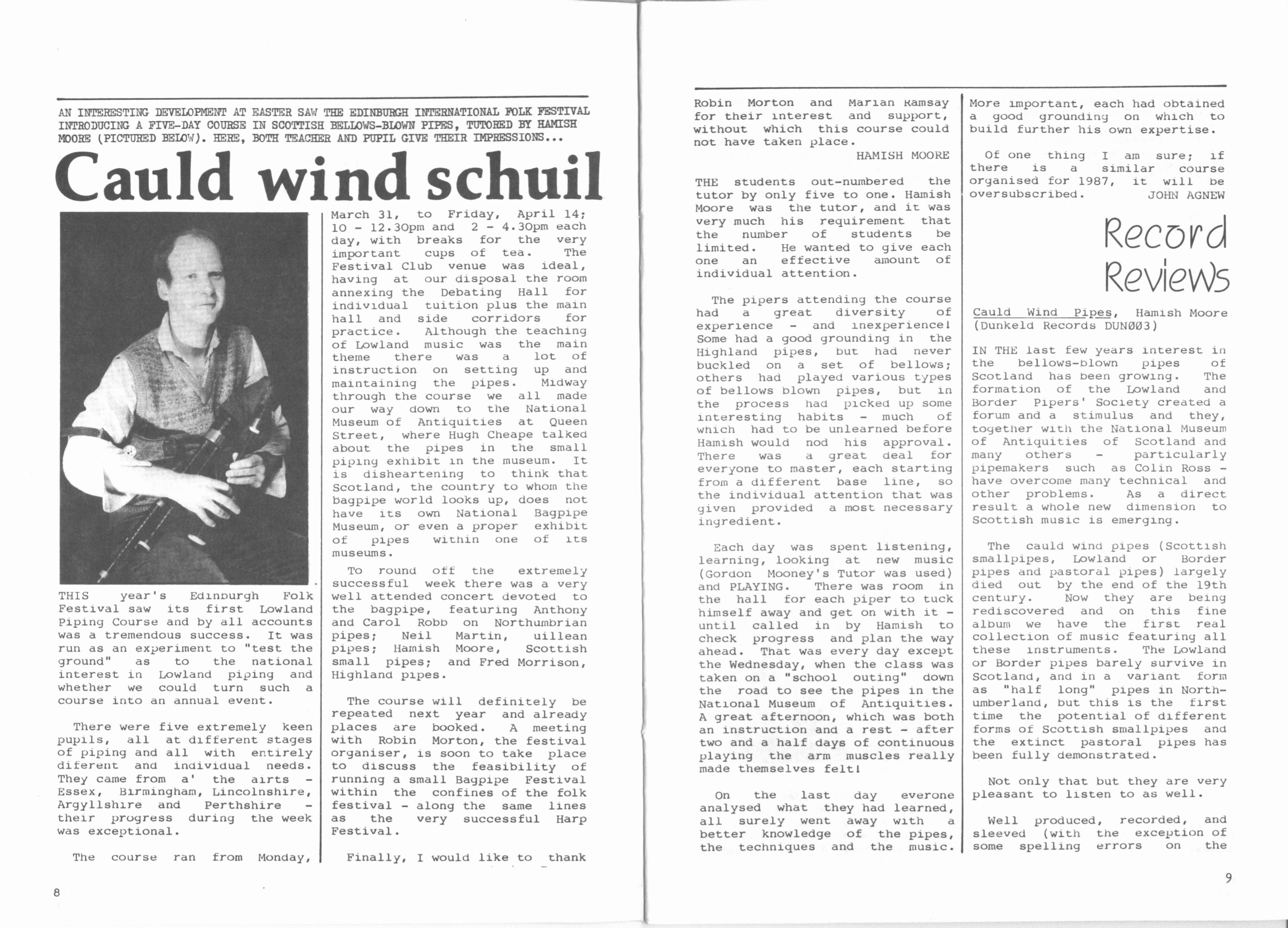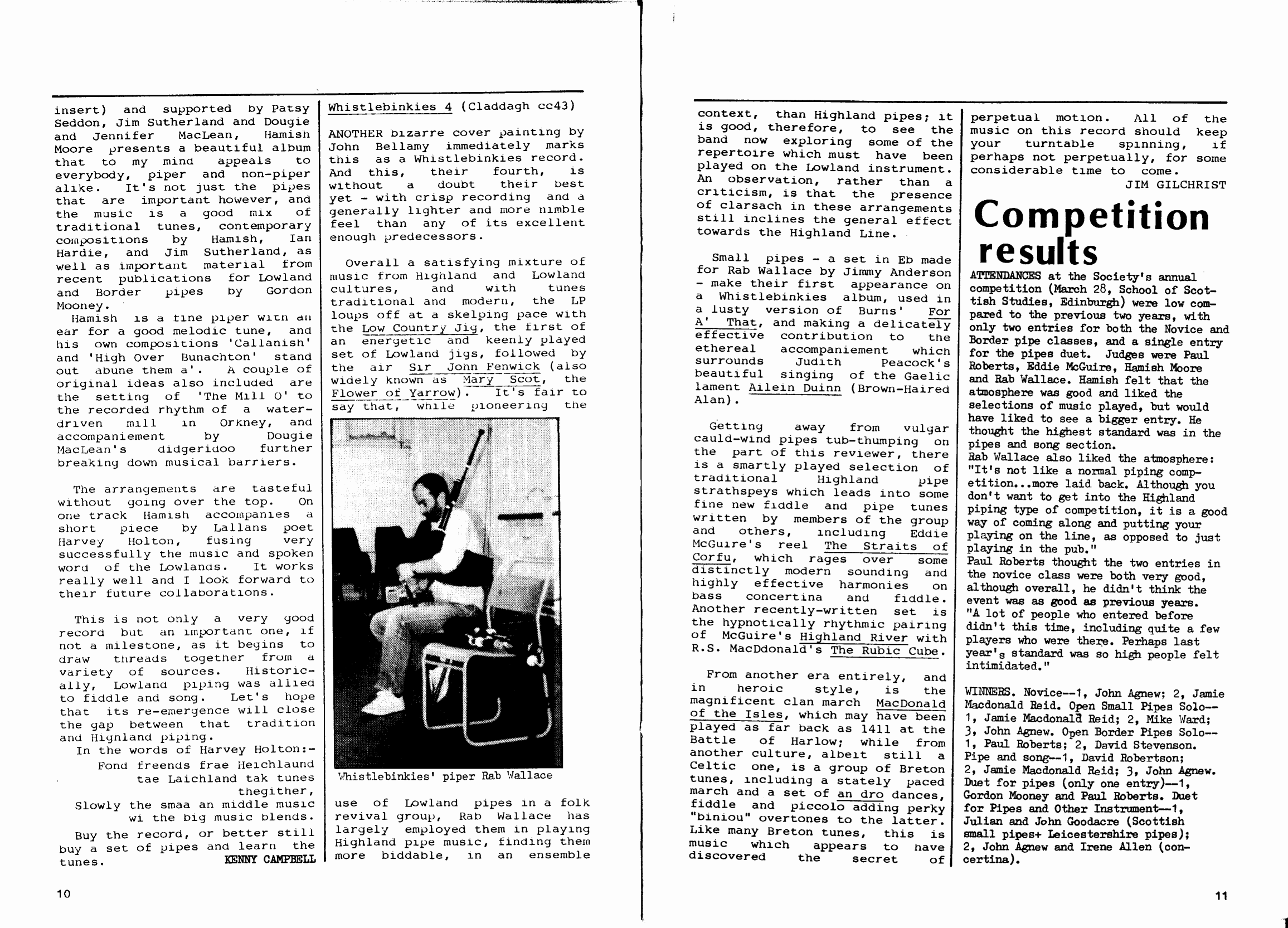Record review 1986: Whistlebinkies


Cauld Wind Pipes, Hamish Moore
(Dunkeld Records DUN003)
IN THE last few years interest in the bellows-
blown pipes of Scotland has been
growing. The formation of the Lowland
and Border Pipers' Society created a
forum and a stimulus and they, together
with the National Museum of Antiquities
of Scotland and many others - particularly
pipemakers such as Colin Ross—have
overcome many technical and other problems.
As a direct result a whole new
dimension to Scottish music is emerging.
The cauld wind pipes (Scottish
smallpipes, Lowland or Border pipes and
pastoral pipes) largely died out by the end
of the 19th century. Now they are being
rediscovered and on this fine album we
have the first real collection of music featuring
all these instruments. The Lowland
or Border pipes barely survive in Scotland,
and in a variant form as "half long"
pipes in Northumberland, but this is the
first time the potential of different forms
of Scottish smallpipes and the extinct
pastoral pipes has been fully demonstrated.
Not only that but they are very pleasant to
listen to as well. Well produced, recorded,
and sleeved (with the exception of some
spelling errors on the insert) and supported
by Patsy Seddon, Jim Sutherland
and Dougie and Jennifer MacLean,
9
Moore presents a beautiful album that to
my mind appeals to everybody, piper and
non-piper alike. It's not just the pipes that
are important however, and the music is a
good mix of traditional tunes, contemporary
compositions by Hamish, Ian Hardie,
and Jim Sutherland, as well as important
material from recent publications
for Lowland and Border pipes by Gordon
Mooney.
Hamish is a fine piper with an ear for a
good melodic tune, and his own compositions
'Callanish' and 'High Over Bunachton’
stand out abune them a’. A couple of
original ideas also included are the setting
of ‘The Mill O' to the recorded
rhythm of a waterdriven mill an Orkney,
and
accompaniment by Dougie MacLean's
didgeridoo further breaking down musical
barriers. The arrangements are tasteful
without going over the top. On one
track Hamish accompanies a short piece
by Lallans poet Harvey Holton, fusing
very successfully the music and spoken
word of the Lowlands. It works really
well and I look forward to their future
collaborations. This is not only a very
good record but an important one, if not a
milestone, as it begins to draw threads
together from a variety of sources. Historically,
Lowland piping was allied to
fiddle and song. Let's hope that its reemergence
will close the gap between
that tradition and Highland piping.
In the words of Harvey Holton:-
Fond freends frae Heichlaund tae Laichland
tak tunes thegither,
Slowly the smaa an middle music
wi the big music blends.
Buy the record, or better still buy a set of
pipes and learn the tunes. Kenny Campbell
ANOTHER bizarre cover painting by John
Bellamy immediately marks this as a Whistlebinkies
record. And this, their fourth, is
without a doubt their best yet - with crisp recording
and a generally lighter and more nimble
feel than any of its excellent enough
predecessors.
Overall a satisfying mixture of music from
Highland and Lowland cultures, and with
tunes traditional and modern, the LP loups off
at a skelping pace with the Low Country Jig,
the first of an energetic and keenly played
set of Lowland jigs, followed by the air Sir
John Fenwick (also widely known as Mary
Scot, the Flower of Yarrow). ~ It’s fair to
say that while pioneering the Whistlebinkies'
use of Lowland pipes in a folk revival group,
Rab Wallace has largely employed them in
playing Highland pipe music, finding them
more biddable, in an ensemble context, than
10
Highland pipes; it is good, therefore, to see
the band now exploring some of the
repertoire which must have been played on
the Lowland instrument. An observation,
rather than a criticism, is that the presence
of clarsach in these arrangements still
inclines the general effect towards the Highland
Line.
Small pipes - a set in Eb made for Rab Wallace
by Jimmy Anderson - make their first
appearance on a Whistlebinkies album, used
in a lusty version of Burns’ For A‘ That, and
making a delicately effective contribution to
the ethereal accompaniment which surrounds
Judith Peacock's beautiful singing of
the Gaelic lament Ailein Duinn (Brown-
Haired Alan).
Getting away from vulgar cauld-wind pipes
tub-thumping on the part of this reviewer,
there is a smartly played selection of
traditional Highland pipe strathspeys which
leads into some fine new fiddle and pipe
tunes written by members of the group
and others, including Eddie McGuire's reel
The Straits of Corfu, which rages over some
distinctly modern sounding and highly effective
harmonies on bass concertina and fiddle.
Another recently-written set is the hypnotically
rhythmic pairing of McGuire's
Highland River with R.S. MacDonald's The
Rubic Cube.
From another era entirely, and in heroic
style, is the magnificent clan march Mac-
Donald of the Isles, which may have been
played as far back as 1411 at the Battle of
Harlaw; while from another culture, albeit
still a Celtic one, is a group of Breton tunes,
including a stately paced march and a set of
an dro dances, fiddle and piccolo adding
perky “biniou" overtones to the latter. Like
many Breton tunes, this is music which appears
to have discovered the secret of
perpetual motion. All of the music on this
record should keep your turntable spinning,
if perhaps not perpetually, for some
considerable time to come.
JIM GILCHRIST
